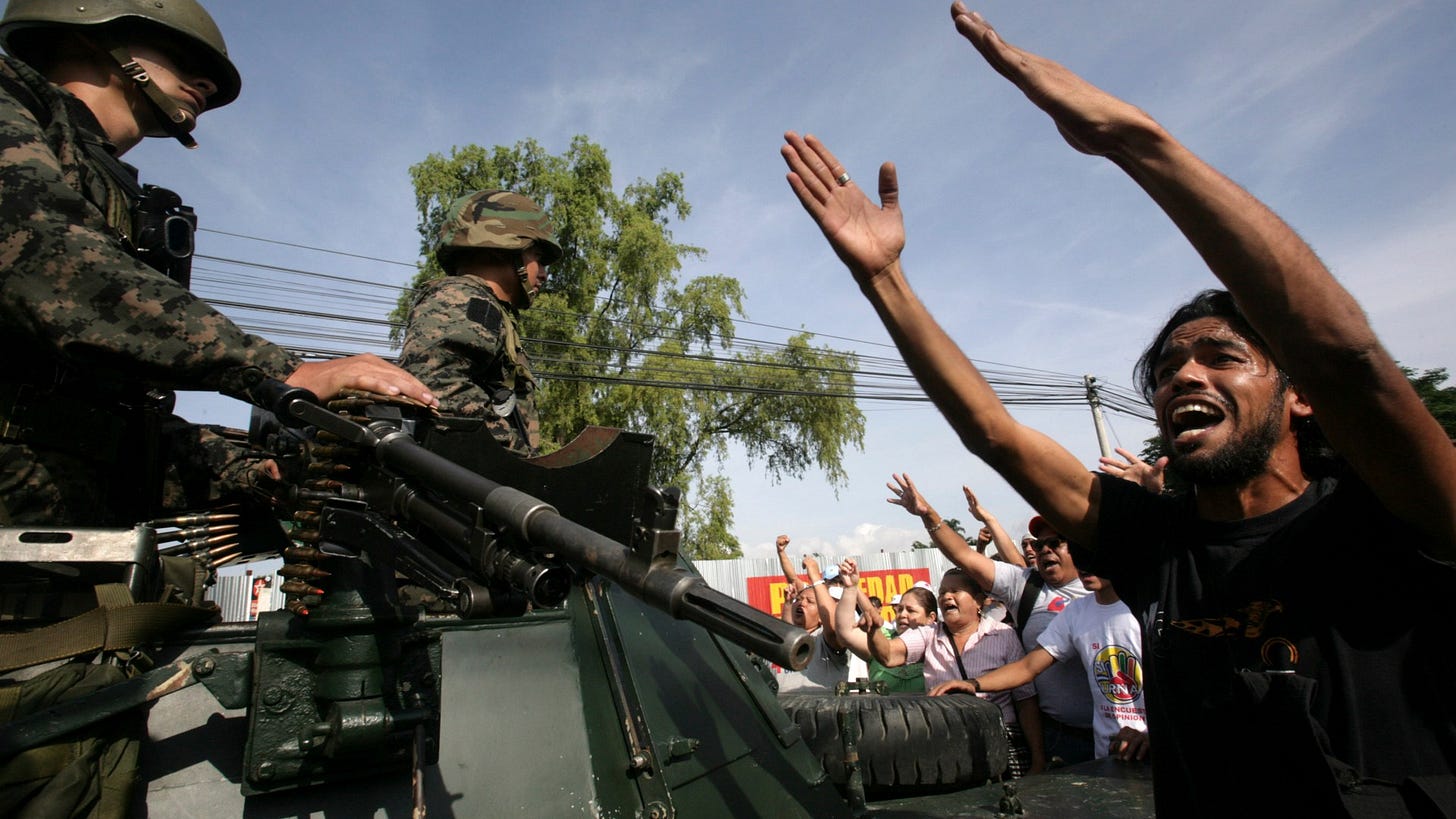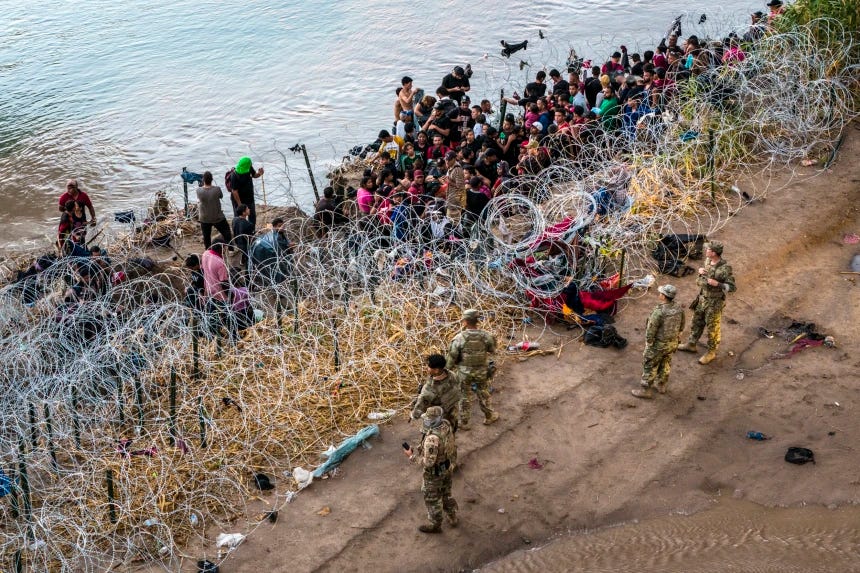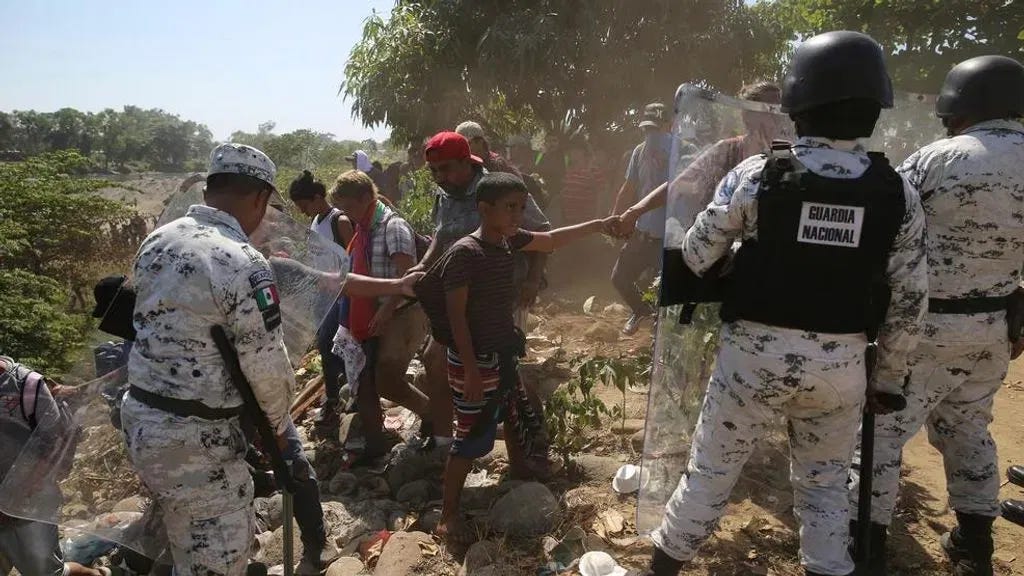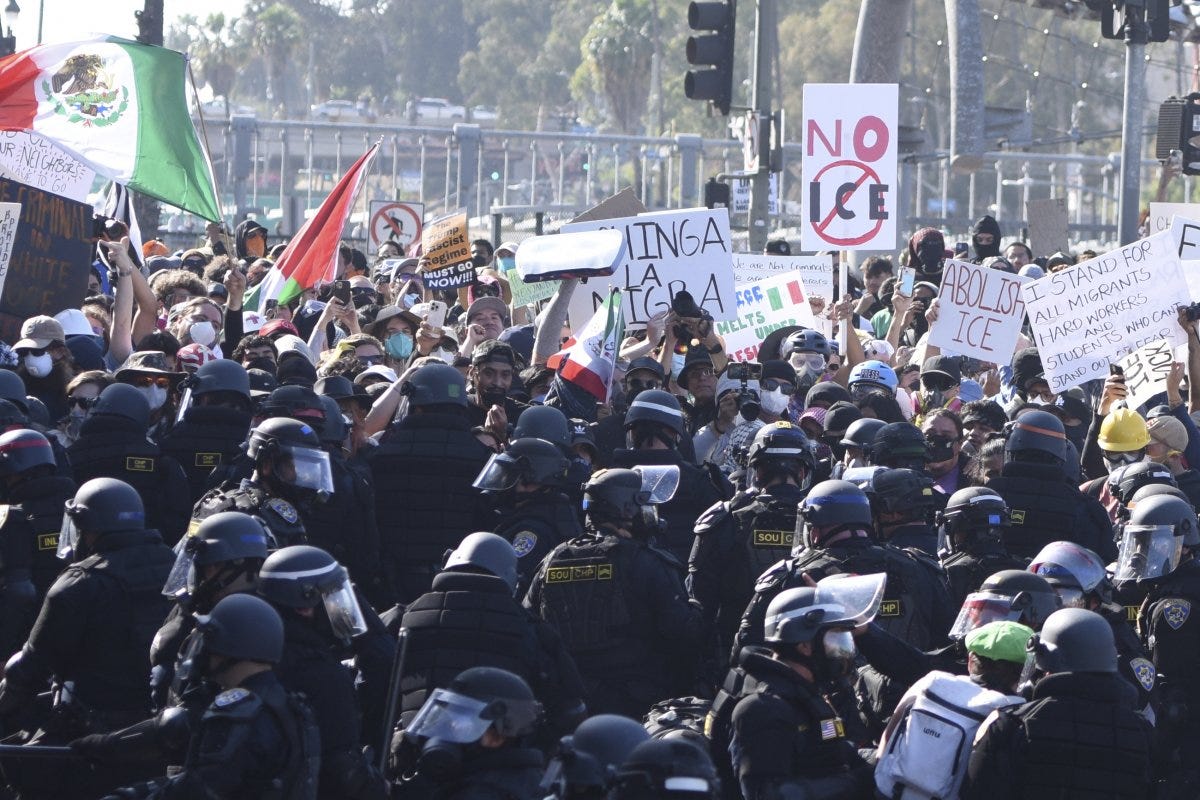A Crisis Designed to Last (Part Two)
Imperialism, Migration, and the Logic of Control
🎧 Prefer to listen? You can hear the full essay above, narrated by Kyle LeMieux.
This essay builds on Part One, which examined how the U.S. immigration regime functions as a domestic tool of class control, using the language of human rights to maintain an undocumented underclass and suppress labor organizing.
Migration Isn’t a Crisis, It’s an Aftershock
Every crisis at the border is treated like a mystery. Why are so many people coming? What broke in their countries? What can we do to stop it?
But migration is not a natural disaster. It’s not a failure of governance or a sudden collapse of order. It is the predictable result of policies the United States helped design and continues to enforce.
These policies are meant to restructure foreign economies for the benefit of U.S. capital. When states resist or try to chart an independent path, they’re met with coups, sanctions, or militarization. Cuba is a key example (as we discussed here); its revolution survived decades of U.S.-imposed economic isolation and military provocations, but the embargo continues to confine and punish it. The same patterns echo across the region: from Central America to the Caribbean to South America, displacement is the intended outcome of a system built to extract, dominate, and discard.

In Honduras, the U.S. backed a 2009 coup that overthrew a moderately reformist president and installed a regime that unleashed cartel violence, gutted public institutions, and enabled oligarchic rule. The result was mass poverty, widespread femicide, and an explosion of gang-related displacement. That government was trained, armed, and legitimized by U.S. policy.
In Guatemala, U.S. support for a decades-long military dictatorship, including CIA training for death squads, culminated in genocide against the Indigenous Maya population. After the war, neoliberal restructuring guaranteed that land remained in the hands of elites. The peasantry was left with dispossession, food insecurity, and climate vulnerability.
In Haiti, the United States helped remove elected governments on multiple occasions, imposed IMF austerity measures, and enforced crushing sanctions. International “aid” was often tied to U.S. contractors and privatization schemes, dismantling what little public infrastructure remained. The country is now called a “failed state,” but it didn’t fail: it was broken.
In Mexico, NAFTA flooded the country with cheap U.S. corn, decimating small-scale agriculture. Millions were forced into precarious urban labor or driven north in search of survival. In the 1980s and ’90s, facing unpayable debt and predatory interest payments to Washington and the IMF, Mexico was pressured into sweeping structural adjustment programs in exchange for financial aid. These policies slashed public services, privatized key industries, and stripped protections for domestic producers. What followed was a gutted economy: profitable for foreign investors, but devastating for working people. Similar trade regimes across the region made extraction more profitable and self-sufficiency impossible.
And in Venezuela, the United States has pursued one of the most aggressive sanctions campaigns in modern history, cutting the nation off from global markets, freezing assets, and fueling economic collapse. A 2019 report by the Center for Economic and Policy Research estimated that U.S. sanctions contributed to over 40,000 deaths in just two years. Millions have since fled from a system strangled by economic warfare, not from socialism.

None of this is ancient history, and it’s bipartisan. Clinton championed NAFTA. Obama backed coups in Honduras and refused to restore elected governments. Biden preserved most of Trump’s sanctions and many others from prior administrations, even expanding some and adding new ones of his own. The logic of U.S. imperialism shifts only to maintain control, rather than due to changes in administrations.
These conditions persist and deepen by design. Washington continues to fund police and military forces across Central America. It props up compliant governments that open markets to U.S. capital and suppress local resistance. It enforces debt regimes that strip nations of policy autonomy. When people inevitably flee, the U.S. responds with fences, drones, and armed agents.
The evidence is clear. According to U.S. Customs and Border Protection, as of 2024, the largest groups arriving at the southern border were migrants from Mexico, Venezuela, Guatemala, Cuba, and Honduras: all countries directly impacted by U.S. interventions, coups, or sanctions. These states are functioning exactly as imperial strategy intended: subordinated, unstable, and unable to meet the needs of their people. Yet their collapse is framed as failure rather than blowback.
When Democrats call for more “orderly” immigration systems, and Republicans call for more force, they are responding to the same phenomenon, a global system of dispossession that both parties helped build. The problem isn’t that too many people are coming. It’s that the system driving them out has never been confronted.
To reduce migration, you have to stop manufacturing refugees.
But that would mean giving up the very tools that keep U.S. dominance in place.
Like what you’re reading?
Subscribe here for weekly essays that challenge power, not just critique it.
Globalizing Control: The Illusion of Sovereignty
The system that produces displacement also enforces it, far beyond U.S. soil.
U.S. immigration enforcement is often justified in the language of national sovereignty; the right of a nation to control who enters, who stays, and under what conditions. But this framing conceals a deeper truth: what the United States defends is not democratic self-determination, but the global reach of capital.
Real sovereignty means that nations can determine their own economic paths, set independent policies, and protect the welfare of their populations. It implies freedom from coercion, not just the protection of borders. Yet when countries in the Global South attempt to assert this kind of sovereignty by nationalizing resources, refusing debt servitude, or breaking from neoliberal trade frameworks, the U.S. responds with sanctions, coups, or regime change.
This contradiction exposes what U.S. “border security” truly serves. It is not the sovereignty of nations, but the sovereignty of markets. What is being defended is access to labor, to resources, to consumer bases: all under terms favorable to U.S. corporate and geopolitical interests.
And this illusion isn’t just for domestic consumption. Washington routinely pressures neighboring countries to act as buffers against migration, outsourcing enforcement through bilateral agreements, aid conditionality, and diplomatic strong-arming. Mexico and Guatemala, for instance, have been enlisted to militarize their own borders and detain asylum-seekers, not to protect their sovereignty, but to help the United States control movement upstream. The logic is clear: the empire exports its border to manage the displacement it causes.
This process, known as border externalization, mirrors broader imperialist structures. Just as the U.S. imposes economic rules on other countries through the IMF and World Bank, it also imposes migration controls through security aid, training programs, and surveillance infrastructure. In both cases, the goal is the same: maintain a global order in which people and states are disciplined into compliance, while capital remains unbound.

The U.S. is not alone in this strategy. Its border regime is part of a larger trend toward globalized migration control, in which wealthy nations fortify themselves against the instability their own policies have caused.
In Europe, the so-called Fortress Europe model involves walls, checkpoints, and pushbacks. At the EU’s physical borders, but also deep into North and West Africa through partnerships with militarized regimes funded by the West. Australia detains asylum-seekers on remote Pacific islands, far from legal oversight. Israel boasts one of the most advanced biometric surveillance systems in the world, aimed not just at Palestinians, but at African migrants deemed undesirable.
These systems resemble each other, but they also collaborate. Surveillance software, drone technology, biometric databases, and AI-powered risk assessments are developed in one country and sold or licensed to others. The same tools used to track undocumented migrants in Texas show up in the Mediterranean. The same private contractors who build detention centers for ICE also build them for the UK Home Office. This is surveillance capitalism with imperial characteristics, where borders become nodes in a global infrastructure of exclusion and control.
In many cases, these technologies are sold under the banner of “capacity-building,” with border militarization folded into humanitarian aid or economic development packages. But the results are clear: nations forced to bear the burden of Western crises are transformed into enforcers of the Western order.
The promise of sovereignty, then, becomes a trap. Poor nations are told they must crack down on migration to prove their legitimacy. Yet the underlying drivers of displacement, such as war, debt, extraction, and climate collapse, remain untouched. Sovereignty is reduced to service: service to capital, to hegemony, to the smooth functioning of a system that creates movement only to criminalize it.
The more the United States exports its border regime, the more it reveals its true function. Not to protect, but to project. Not to preserve order, but to globalize control.
When Empire Turns Inward
As U.S. global hegemony falters, its repressive tools are turning inward.
The immigration regime has always served a dual function: managing people and maintaining political order. And today, as that order falters, the state is no longer content with controlling who gets in. It’s focused on controlling what can be said once you’re here.
That’s why immigration enforcement is shifting targets. Not just detaining the undocumented, but surveilling and expelling those with valid visas. Not just deporting workers, but silencing students, professors, and activists. Especially those critical of U.S. policy in Gaza.
Under Trump, this shift is being made explicit. In speeches, executive actions, and secretive deals, the line between immigration law and political punishment is dissolving. Deportation is becoming a tool of domestic counterinsurgency.
But this evolution did not begin with Trump.

Since 9/11, immigration enforcement has increasingly mirrored military and intelligence operations. ICE was born not as a civilian agency, but as an arm of Homeland Security. It shares tactics and resources with the NSA and FBI. Its raids resemble SWAT team assaults. Agents increasingly operate in plain clothes, wear masks, and refuse to identify themselves, tactics once reserved for clandestine foreign operations, now deployed against communities at home. Its surveillance tools: facial recognition, data scraping, and phone tracking, were built for counterterrorism.
These technologies were first justified as necessary to stop foreign threats. Then, to track “criminal aliens.” Now, they’re aimed at dissenters. The target has changed, but the logic remains: preempt, isolate, and punish.
As the empire loses legitimacy abroad, it compensates by criminalizing resistance at home.
This repression is especially concentrated at the intersection of race, class, and politics. The migrant who organizes a labor strike. The student who protests genocide. The journalist who questions state violence. These are no longer seen as participants in civil society, but as risks to national security.
The narrowing of asylum laws, the revocation of visas, and the threats of lifelong detention abroad are a pattern. A warning. They mark a transition from managing movement to managing thought.
The border becomes not just a line on a map, but a weapon in the culture war. A symbol of control. A test of loyalty.
And like all tools of empire, it eventually points inward.
The U.S. immigration regime is about control. Of labor and dissent. Of global instability and domestic obedience. And it will not fall through reform alone, but through dismantling the imperial foundations it was built to defend.
The Left Cannot Cede This Terrain
Liberal immigration discourse has collapsed. Once defined by vague calls for “reform,” it now offers little more than reaction to Republican cruelty. Meanwhile, the far right continues to dominate the conversation, channeling frustration into open xenophobia and violent nationalism. But beneath both is a shared commitment to managing migration, not ending the system that produces it.
This is the terrain the left must seize, or surrender the fight entirely.

The solution is not “open borders,” a phrase often invoked by critics but rarely championed with any political substance. When liberal commentators do use it, it’s either as a utopian flourish or a rhetorical shield, a gesture toward compassion with no plan to dismantle the forces driving displacement or labor exploitation.
The alternative isn’t more efficient enforcement. It’s a new foundation for solidarity: one rooted in global class struggle, anti-imperialism, and the right to remain.
That means rejecting the false binary of cruelty versus compassion, a framework that treats enforcement style as the issue, not the imperial structure beneath it. It means confronting the causes of migration at their root: sanctions, coups, trade deals, and labor extraction. It means standing not just with those crossing borders, but with those resisting the forces that make them flee.
A class-based approach must also challenge the domestic consequences of the current regime. As long as an undocumented underclass exists, all workers are vulnerable. Wages are suppressed. Organizing is stifled. The deportation threat doesn’t just target the migrant; it disciplines the entire working class.
The only path forward is internationalism.
As Marx wrote in The Communist Manifesto, “Workers of the world, unite. You have nothing to lose but your chains!” But that unity cannot happen while nationalism defines the boundaries of solidarity. A movement that limits its imagination to the nation-state will always be forced to choose between policing borders and ignoring them.
We must do neither. We must dismantle them.
Control Is the Crisis
The immigration regime is not solving a crisis. It is the crisis. A tool of control, calibrated to manage labor, suppress dissent, and sustain the very conditions that produce displacement in the first place.
It does not protect sovereignty. It protects capital.
It does not stop violence. It redistributes it away from the rich, toward the poor; away from the imperial core, toward the periphery. Now, that violence is increasingly turning inward, too.
The same militarized forces once reserved for borderlands are now deployed in American cities. Immigration enforcement has become a domestic weapon, used against undocumented workers but also against protestors, students, and anyone who resists.
It will not be dismantled by liberal reforms or reactionary violence. It will only fall when we confront the forces that built it.
This is about the broader logic of imperialism. Lenin’s warning still resonates: “No nation can be free if it oppresses other nations.” The same is true of people. So long as our economy depends on a tiered system of labor, one group protected, the other punished, we will not have justice. We will have management.
To end the crisis, we must resist the ongoing violence of global exploitation, not just the visible cruelty of border repression. That means rejecting nationalism as the framework for solidarity. It means organizing across lines of citizenship, language, and legal status. And it means recognizing that the only real solution lies in transforming the conditions that displace and divide them.
Next week, we’ll follow the logic of empire into new terrain: from the boardrooms of the IMF to the economic warfare of sanctions. These are not just tools of control, they are the mechanisms that have pushed entire nations into crisis, displacing millions and fueling the very migration the U.S. seeks to police.
The International Dictatorship of the Dollar
The Empire of Finance, Explained
will be published Tuesday, July 29 at 11 AM ET.
Subscribe to be notified when it goes live.
Further Reading
For those seeking to delve beyond policy debates and comprehend the immigration regime as a system of global control, these books offer essential context. One traces how imperial violence creates displacement; the other explains how borders manage that displacement in service of capital.
Liberal Critiques
The Jakarta Method by Vincent Bevins
Traces how U.S. anti-communism shaped a global playbook of repression and displacement. Not a book on borders, but essential for understanding the violence that pushes people to cross them.
Marxist Foundations
Border and Rule by Harsha Walia
The most comprehensive breakdown of how borders function as tools of class, race, and imperial control. Cuts through liberal handwringing and gets to the root.
Understand the world. Change the world.
You’ve read this far for a reason.
You’re not here to be comforted; you’re here because something isn’t adding up.
Let’s figure it out together.
Weekly essays from Concrete Analysis.
Direct. Unapologetic. Grounded in reality.
If something in this piece resonated or challenged you, I’d love to hear your thoughts in the comments below.

